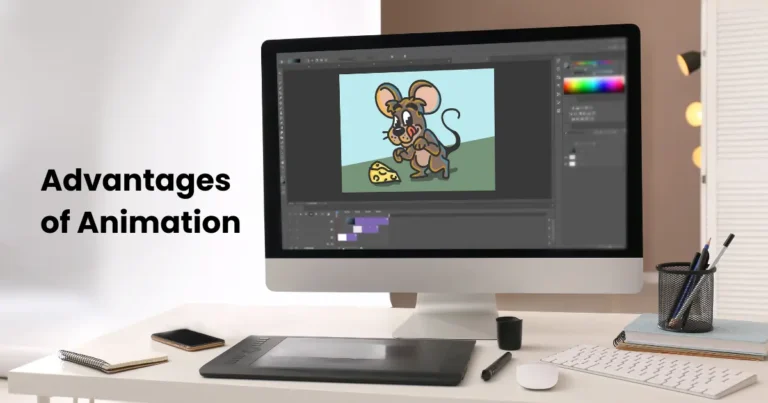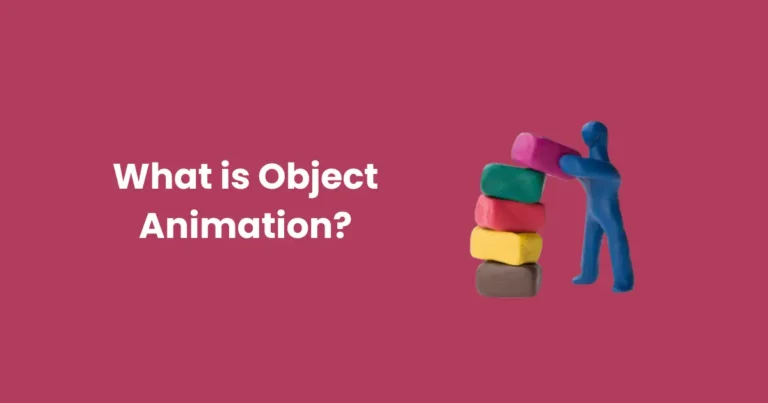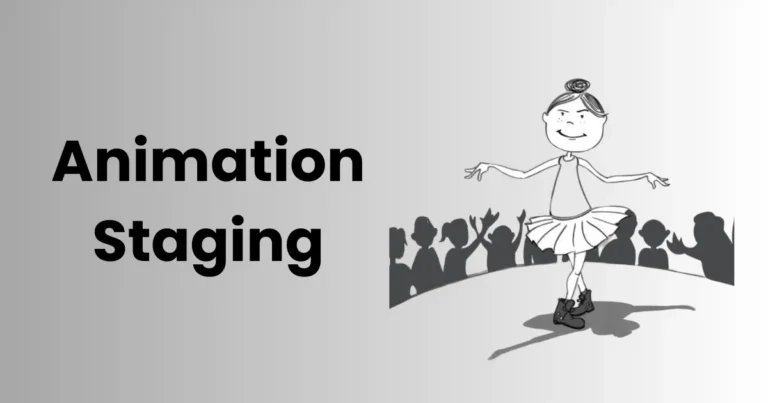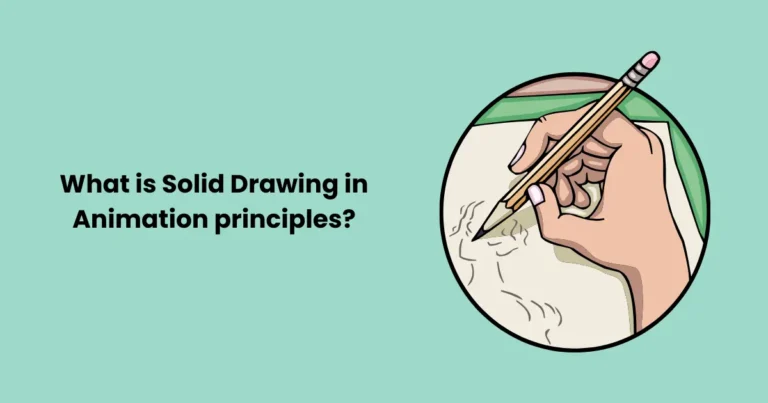straight ahead and Pose to Pose Animation | 12 Principles of Animation
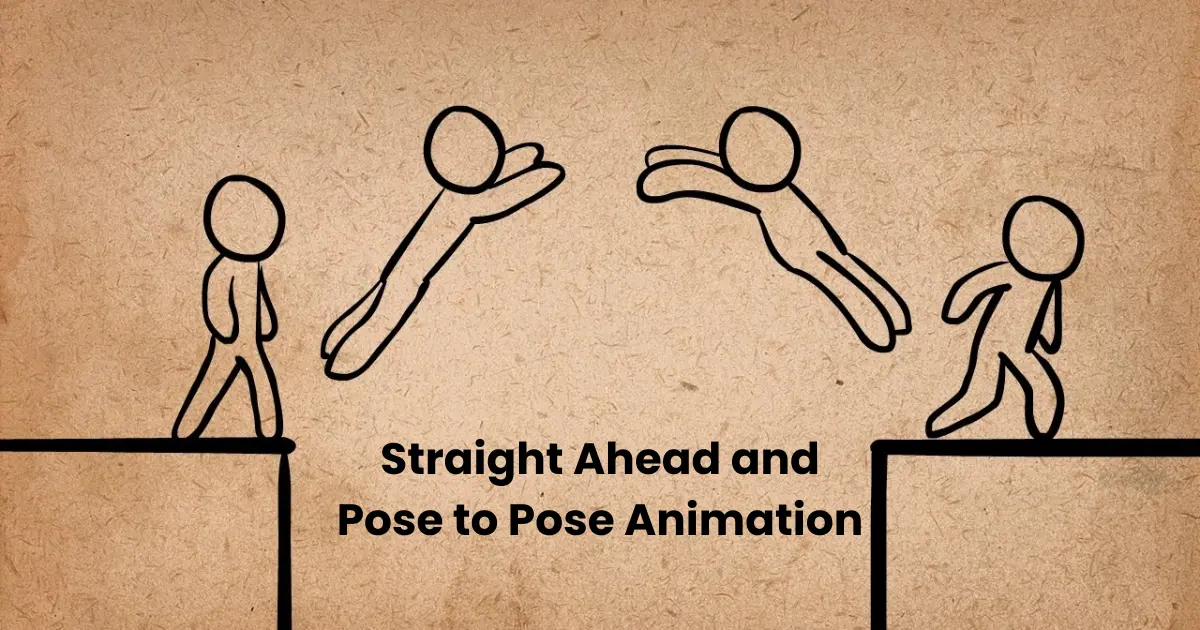
Contents
- 1 The Concept Behind Pose to Pose Animation
- 2 Pose to Pose Animation vs Straight Ahead Animation
- 3 Benefits of Pose to Pose Animation
- 3.1 1. Clear Storytelling and Emotional Impact
- 3.2 2. Enhanced Timing and Pacing Control
- 3.3 3. Consistency in Animation
- 3.4 4. Facilitates Collaboration
- 3.5 5. Easier Adjustments and Refinements
- 3.6 6. Suited for Complex Scenes
- 3.7 7. Professional Workflow Integration
- 3.8 8. Adaptability Across Animation Styles
- 4 How to Create Pose to Pose Animation
- 5 Software for Pose to Pose Animation
- 6 Real-World Applications of Pose to Pose Animation
Straight Ahead And Pose to Pose Animation is a fundamental animation technique that lies at the heart of professional and beginner animation workflows. This method involves creating key poses at significant moments in a sequence, which act as guideposts for the entire animation process. By focusing on these critical moments, animators ensure that the storytelling, timing, and overall structure of the animation are clear and visually appealing.
Unlike the straight-ahead animation technique, where animators draw frame by frame in sequence, Pose to Pose Animation allows for better planning and control over the action. It ensures that the animation hits all the necessary story beats while maintaining consistency.
Whether you’re working on 2D or 3D projects, Pose to Pose Animation provides the flexibility to refine movements, adjust timing, and ensure smoother transitions between poses. This approach is widely used in character animation, action sequences, and complex scenes that demand precision.
The Concept Behind Pose to Pose Animation
Pose to Pose Animation is rooted in the principle of planning and structure, making it a cornerstone of professional animation techniques. At its core, this method revolves around creating key poses, which represent the most critical moments in an animation sequence. These keyframes outline the primary actions and emotions, forming the backbone of the animation.

The process begins with identifying the storytelling beats—moments that are essential to conveying the intended narrative or action. For example, in a jump sequence, the animator would define poses such as the crouch before the leap, the apex of the jump, and the landing. These poses are then linked together with in-between frames, which add fluidity and motion between the key poses.
This approach allows animators to:
- Control timing and pacing: By defining key poses first, you can easily adjust the timing of the animation to suit the mood or action.
- Focus on storytelling: Ensuring that the key moments are impactful and clear enhances the viewer’s understanding of the scene.
- Maintain consistency: By using key poses as anchors, you reduce the risk of inconsistent motion or style.
Pose to Pose Animation is particularly beneficial for complex scenes involving multiple characters or intricate movements. It allows animators to work systematically, ensuring the sequence stays cohesive while leaving room for refinement.
This concept not only streamlines the animation process but also provides a clear roadmap, enabling animators to bring their creative vision to life with precision and efficiency.
Pose to Pose Animation vs Straight Ahead Animation
Pose to Pose Animation and Straight Ahead Animation are two primary approaches animators use to bring their creations to life. While both are effective, they differ significantly in methodology, application, and outcomes. Here’s a detailed comparison to help you understand their distinct characteristics.
Pose to Pose Animation
- Definition: This method focuses on creating key poses at significant moments in the animation sequence, which are later filled in with in-between frames to smooth out motion.
- Approach: Structured and planned, Pose to Pose Animation ensures that the key elements of the animation are well-defined before adding details.
- Applications: Best suited for complex scenes, character-driven storytelling, and animations where timing and precision are critical.
- Advantages:
- Offers better control over timing and movement.
- Facilitates collaboration, as key poses provide a framework for team members.
- Ensures consistency across frames, especially for detailed sequences.
- Challenges: May lack the spontaneity of motion found in more fluid techniques and requires more upfront planning.
Straight Ahead Animation

- Definition: In this approach, animators create frame-by-frame, moving sequentially from start to finish without predefined key poses.
- Approach: Freeform and dynamic, Straight Ahead Animation captures natural, organic motion as it unfolds.
- Applications: Ideal for fluid, unpredictable movements like fire, water, or character animations involving exaggerated physics.
- Advantages:
- Captures fluid and natural motion with ease.
- Encourages creativity and improvisation during the process.
- Challenges:
- Can lead to inconsistencies, as there is no structured roadmap.
- Adjustments to timing or sequence may be difficult once frames are drawn.
Choosing Between the Two
The decision between Pose to Pose Animation and Straight Ahead Animation depends on the project’s requirements:
- Use Pose to Pose Animation when precision, timing, and storytelling are paramount, such as in character-driven narratives or multi-character interactions.
- Opt for Straight Ahead Animation when fluidity and spontaneity are needed, such as animating natural phenomena or dynamic movements.
By understanding the strengths and limitations of both techniques, animators can choose the approach that best suits their creative and technical needs. Often, a hybrid method combining Pose to Pose Animation for structure and Straight Ahead Animation for fluidity yields the most compelling results.
Benefits of Pose to Pose Animation
Pose to Pose Animation is a widely preferred technique among animators, thanks to its structured approach and versatility. Below are the key benefits that make it an essential method for creating high-quality animations.

1. Clear Storytelling and Emotional Impact
By defining key poses, animators can emphasize crucial moments that drive the narrative forward. This ensures the animation effectively conveys emotions, actions, and intentions, keeping the audience engaged.
2. Enhanced Timing and Pacing Control
Pose to Pose Animation allows animators to plan the timing and spacing of actions precisely. By setting keyframes, you can adjust the duration between poses to match the desired rhythm, ensuring smooth and natural motion.
3. Consistency in Animation
This method creates a visual roadmap, making it easier to maintain consistency in character proportions, movements, and expressions across frames. This is especially important in scenes with complex interactions or multiple characters.
4. Facilitates Collaboration
Pose to Pose Animation is particularly helpful in collaborative settings. Key poses act as a guide for team members, ensuring that everyone works toward the same vision, even when multiple animators contribute to a single project.
5. Easier Adjustments and Refinements
Because the animation is built around keyframes, modifications can be made without redoing the entire sequence. This flexibility is invaluable during the editing process, saving time and effort.
6. Suited for Complex Scenes
Whether it’s a detailed character interaction or a scene with intricate mechanics, Pose to Pose Animation provides the structure needed to manage complexity while delivering high-quality results.
7. Professional Workflow Integration
Pose to Pose Animation integrates seamlessly into professional workflows, especially in 3D animation software. Tools like Maya and Blender offer features to create and refine keyframes, making this method more efficient and accessible.
8. Adaptability Across Animation Styles
This technique is not limited to any one medium or style. It is equally effective for traditional 2D animation, stop-motion, and modern 3D animation. Its adaptability makes it a go-to method for animators across industries.
The benefits of Pose to Pose Animation make it an invaluable tool for animators aiming to produce polished, professional-quality work. Its structured approach ensures clarity, precision, and adaptability, making it a cornerstone technique in the animation process. Whether you are a beginner or a seasoned professional, mastering Pose to Pose Animation will significantly enhance your creative output.
How to Create Pose to Pose Animation
Creating Pose to Pose Animation involves a systematic process that ensures clarity, consistency, and smooth motion. Follow these steps to master the technique and bring your animations to life.

1. Plan Your Animation
Before animating, outline the key moments of the sequence. Think about:
- The narrative or action: What story are you telling?
- The character’s emotions and movements: What poses will best express them?
- The timing: How fast or slow should the actions unfold?
Use storyboards or thumbnails to sketch out the sequence. This planning phase sets the foundation for your animation.
2. Define Key Poses
Key poses are the most critical moments in your animation. They represent the start and end of major actions or transitions. For example:
- A character preparing to jump.
- The apex of the jump.
- The landing.
These keyframes capture the essence of the motion and serve as anchors for the animation.
3. Add Breakdown Poses
Breakdown poses come between the keyframes and define how the movement transitions from one key pose to the next. For instance:
- How the character’s body stretches during the jump.
- The anticipation before the landing.
Breakdown poses add nuance and clarity to the motion.
4. Set the Timing and Spacing
Adjust the timing of your keyframes and breakdowns to control the pacing of the animation. Timing refers to how long an action takes, while spacing defines the distribution of frames between poses.
- Use closer frames for slower movements.
- Use spaced-out frames for faster actions.
5. Create In-Between Frames
In-between frames, also known as “tweens,” smooth out the transitions between key poses and breakdowns. These frames ensure fluid motion and fill in the gaps for seamless animation.
6. Review and Refine
Play back your animation to identify any areas that feel stiff or unnatural. Adjust poses, timing, and spacing as needed to enhance the flow and impact of the sequence.
7. Polish the Details
Add secondary actions, such as hair movement or facial expressions, to make the animation more dynamic and lifelike. Ensure these details don’t distract from the primary action but complement it.
8. Finalize and Export
Once satisfied with the animation, render or export it in your desired format. Test it in its intended context, whether it’s part of a larger project or a standalone piece.
Pro Tips for Pose to Pose Animation
- Use reference materials: Study real-life movements or videos to make your animation more authentic.
- Leverage software tools: Programs like Blender, Maya, or Adobe Animate offer features like onion skinning and keyframe interpolation to streamline the process.
- Start simple: Focus on mastering basic actions before tackling complex sequences.
By following these steps, you can create compelling Pose to Pose Animations that are both polished and professional. This technique not only simplifies the animation process but also ensures high-quality results that resonate with your audience.
Software for Pose to Pose Animation
Pose to Pose Animation can be efficiently created using a variety of animation software. These tools are designed to facilitate the keyframe-based workflow, allowing animators to focus on crafting dynamic and visually appealing animations. Here’s a list of the best software for Pose to Pose Animation, along with their standout features.

1. Adobe Animate
- Best For: 2D animation and web-based projects.
- Features:
- Intuitive keyframe management for Pose to Pose workflows.
- Onion skinning to visualize transitions between poses.
- Support for vector-based animations for scalability.
- Why It’s Great: Adobe Animate is beginner-friendly yet powerful enough for professional animations, making it a top choice for 2D Pose to Pose Animation.
2. Blender
- Best For: 3D animations and complex character movements.
- Features:
- Advanced keyframing tools with precise control over timing and interpolation.
- Graph Editor for refining motion curves.
- Rigging tools for creating and animating characters.
- Why It’s Great: Blender is free, open-source, and highly versatile, making it ideal for both beginners and experts working on Pose to Pose Animation in 3D.
3. Autodesk Maya
- Best For: Professional 3D animation projects.
- Features:
- Robust keyframe system for detailed Pose to Pose workflows.
- Tools for rigging, skinning, and animating complex models.
- Graph Editor and Time Slider for precise control over motion and timing.
- Why It’s Great: Maya is a gold standard in the animation industry, offering unparalleled control and features for creating polished Pose to Pose animations.
4. Toon Boom Harmony
- Best For: High-quality 2D animations.
- Features:
- Integrated tools for keyframing, rigging, and in-betweening.
- Onion skinning and advanced timeline features.
- Customizable brushes and drawing tools for unique styles.
- Why It’s Great: Used by industry giants like Disney, Toon Boom Harmony is perfect for animators who want professional-grade 2D animations with a Pose to Pose approach.
5. Moho (Anime Studio)
- Best For: 2D character animation.
- Features:
- Bone rigging system for smooth character movements.
- Keyframe interpolation for creating in-between frames.
- Timeline-based workflow tailored for Pose to Pose Animation.
- Why It’s Great: Moho combines powerful features with ease of use, making it a go-to option for animators focusing on character-driven 2D projects.
6. TVPaint Animation
- Best For: Hand-drawn animations.
- Features:
- Frame-by-frame drawing tools for detailed pose creation.
- Customizable timeline for managing key poses and breakdowns.
- Supports bitmap-based animation for unique textures.
- Why It’s Great: TVPaint is ideal for animators who prefer traditional, hand-drawn Pose to Pose workflows but want the efficiency of modern software.
7. Synfig Studio
- Best For: Beginners and hobbyists in 2D animation.
- Features:
- Vector-based animation tools for scalable graphics.
- Keyframe-based workflow for Pose to Pose animation.
- Free and open-source platform.
- Why It’s Great: Synfig is perfect for those new to animation, offering a straightforward interface and tools for creating Pose to Pose animations without a steep learning curve.
Choosing the right software for Pose to Pose Animation depends on your project’s requirements, skill level, and budget. Whether you’re creating 2D or 3D animations, tools like Blender, Maya, and Toon Boom Harmony provide professional-grade capabilities. For beginners or those exploring animation, software like Adobe Animate or Synfig Studio offers an excellent starting point.
Real-World Applications of Pose to Pose Animation
Pose to Pose Animation is a versatile technique that has become a cornerstone in various industries. Its structured and adaptable approach makes it suitable for projects ranging from entertainment to education and beyond. Here are some real-world applications of Pose to Pose Animation:

1. Film and Television
- Application: Used extensively in animated movies, TV shows, and series to create visually captivating and emotionally resonant scenes.
- Example: Studios like Disney and Pixar rely on Pose to Pose Animation to craft key emotional beats and action sequences. Key poses ensure that every frame serves the story and maintains character consistency.
- Why It Works: The technique provides precise control over character timing and emotions, ensuring a seamless storytelling experience.
2. Video Games
- Application: Pose to Pose Animation is widely used in game development to animate characters, objects, and cutscenes.
- Example: Games like The Last of Us and Assassin’s Creed employ this method to create lifelike character movements and interactions.
- Why It Works: Key poses in game animation help ensure responsiveness and fluidity while aligning with gameplay mechanics and player input.
3. Advertising and Marketing
- Application: Animated commercials and explainer videos often use Pose to Pose Animation to convey messages effectively.
- Example: Companies like Coca-Cola and Apple use animated advertisements to engage audiences with dynamic visuals and storytelling.
- Why It Works: This method ensures that the animation is clear, visually appealing, and aligned with the brand’s messaging.
4. Education and E-Learning
- Application: Pose to Pose Animation is used in educational content to simplify complex topics and make learning engaging.
- Example: Animated tutorials, science demonstrations, and historical recreations leverage this technique for clear and structured visuals.
- Why It Works: The technique helps deliver information in a visually coherent manner, ensuring learners stay focused and absorb content effectively.
5. Virtual Reality (VR) and Augmented Reality (AR)
- Application: Creating immersive VR and AR experiences relies heavily on precise animation to guide users through interactive environments.
- Example: VR games and training simulations utilize Pose to Pose Animation to animate characters and objects within virtual spaces.
- Why It Works: The technique ensures animations are consistent and lifelike, enhancing the user experience in immersive applications.
6. Medical and Scientific Visualization
- Application: Used to create animated models that explain medical procedures or scientific phenomena.
- Example: Animations showing how the human body functions or simulating surgical procedures for training.
- Why It Works: Pose to Pose Animation allows for accurate representation of complex processes with clear and precise keyframes.
7. Corporate Training and Simulations
- Application: Many corporate training modules and simulations use Pose to Pose Animation to depict real-world scenarios.
- Example: Animations that simulate customer interactions, workplace safety scenarios, or machinery operation.
- Why It Works: The structured approach ensures clarity, making it easier to train employees effectively.
8. Social Media and Content Creation
- Application: Short animations for platforms like Instagram, TikTok, and YouTube often rely on Pose to Pose techniques for quick yet impactful content.
- Example: Explainer animations, storytelling reels, or branded content for social media campaigns.
- Why It Works: The method ensures key moments in the animation capture attention, making content more engaging and shareable.
The applications of Pose to Pose Animation are vast and span multiple industries. Its ability to deliver clear, consistent, and impactful animations makes it an essential tool for animators across domains. From entertaining millions in movies to simplifying education or enhancing virtual experiences, Pose to Pose Animation continues to shape the way we interact with visual storytelling in the real world.
Conclusion
Pose to Pose Animation stands as a cornerstone technique in the world of animation, offering a structured and reliable method for creating dynamic and impactful visuals. By focusing on keyframes and carefully transitioning between them, this technique allows animators to maintain control over timing, spacing, and storytelling, ensuring that the end result is both polished and engaging. Whether in the context of a blockbuster movie, a video game, or an educational tutorial, Pose to Pose Animation proves its versatility and effectiveness in delivering compelling motion and clear narratives.
From its application in professional industries like film, gaming, and advertising to its use in emerging fields like virtual reality and corporate training, Pose to Pose Animation continues to shape how visual stories are told. By mastering this technique, animators can elevate their work, ensuring consistency, emotional depth, and clarity in every project. Its timeless appeal and adaptability make it a critical skill for beginners and seasoned professionals alike, solidifying its place at the heart of modern animation workflows.

